As a journalist in today’s digital newsroom, it is normal to be surrounded by internet-connected devices that promise greater convenience but also open one’s organization to new security risks. As newsrooms adopted internet-of-things technology, from smart TVs to voice-activated assistants, leadership touted the efficiency gains. However, the attack surface expanded as these devices gained access to the network. Ponder the implications of speaker microphones always listening and smart screens tracking faces. What data do these devices collect, and how secure is it? As you prepare your next big scoop, you must weigh productivity against vulnerabilities introduced by IoT in the newsroom.
Introduction to IoT and Its Use in Modern Newsrooms
The IoT Revolution
- The Internet of Things (IoT) has ushered in a new era of connectivity, where everyday devices can communicate and share data over the internet. From smart home appliances to industrial sensors, IoT technology has permeated nearly every aspect of modern life. In the fast-paced world of news media, IoT devices have found their way into newsrooms, offering both opportunities and challenges.
IoT in Newsroom Operations
- Modern newsrooms are embracing IoT solutions to streamline operations and enhance reporting capabilities. Smart sensors can monitor environmental conditions, such as temperature and humidity, ensuring optimal performance of sensitive equipment. IoT-enabled cameras and microphones can capture high-quality audio and video footage, facilitating remote news gathering and live reporting.
- Furthermore, IoT devices can automate routine tasks, freeing up journalists to focus on more critical aspects of their work. For instance, smart lighting systems can adjust illumination levels based on occupancy, reducing energy consumption and costs.
Data-Driven Journalism
- Beyond operational efficiency, IoT technology has opened new avenues for data-driven journalism. Newsrooms can leverage IoT sensor networks to collect real-time data on various topics, from air quality and traffic patterns to social media sentiment analysis. This wealth of data can inform in-depth investigative reporting, providing journalists with valuable insights and supporting evidence.
- Moreover, IoT devices can facilitate citizen journalism, enabling the public to contribute data and eyewitness accounts, enhancing news coverage, and fostering community engagement.
Security Implications
- While IoT technology offers numerous advantages, it also introduces significant security risks. Many IoT devices lack robust security features, making them vulnerable to cyber threats such as hacking, data breaches, and distributed denial-of-service (DDoS) attacks. In a newsroom setting, compromised IoT devices could expose sensitive information, jeopardize the integrity of reporting, or even disrupt critical operations.
As newsrooms increasingly rely on IoT solutions, implementing robust cybersecurity measures becomes paramount. This includes ensuring proper device authentication, encryption, and regular software updates to mitigate potential vulnerabilities.
Potential IoT Security Risks for Journalists

As IoT devices become ubiquitous in newsrooms, it’s crucial to understand the potential security risks they pose. These connected devices can inadvertently expose sensitive information if not properly secured.
Unauthorized Access
- One major concern is unauthorized access to IoT devices by malicious actors. Weak passwords, unsecured networks, or vulnerabilities in device firmware could allow hackers to gain control. This risks the exposure of confidential data, and sources, or even compromising the integrity of published stories.
Eavesdropping and Data Leaks
- Many IoT devices, like smart assistants or video conferencing equipment, rely on microphones and cameras. A compromised device could enable eavesdropping on private conversations or leaking visual data, violating source confidentiality and journalistic ethics.
Distributed Denial of Service (DDoS) Attacks
- IoT botnets, networks of compromised devices, can be leveraged for large-scale DDoS attacks. These could disrupt news outlets’ online presence, crippling their ability to disseminate crucial information promptly.
Lack of Updates and Obsolescence
- Manufacturers may discontinue security updates for older IoT devices, leaving them vulnerable to emerging threats. Newsrooms should regularly audit their IoT inventory and replace obsolete devices to mitigate risks.
- To safeguard against these risks, journalists should take proactive measures. Keep devices updated, use strong authentication, and segment IoT devices on separate networks. Regularly audit devices and disable unnecessary features. A robust cybersecurity strategy is vital to protect the integrity of the journalistic process in an IoT-enabled environment.
Securing Confidential Sources and Materials With IoT Devices
Encryption and Access Control
- As you embrace IoT devices in your newsroom, implementing robust encryption and access control measures becomes paramount. Encrypt all data transmissions involving confidential sources or materials, ensuring only authorized personnel can access this sensitive information. Employ multi-factor authentication, regularly update passwords, and limit access on a need-to-know basis.
Secure Network Segmentation
- Isolate IoT devices handling sensitive data on a separate, highly secure network segment. This “air-gapped” approach minimizes the risk of unauthorized access or data breaches. Regularly monitor and audit this segmented network for any anomalies or potential threats.
Physical Security Measures
- In addition to digital safeguards, physical security measures are equally crucial. Store IoT devices handling confidential data in secure, access-controlled environments. Implement strict policies and protocols for device handling, transportation, and disposal to prevent accidental exposure or theft.
Rigorous Device Vetting
- Thoroughly vet and test all IoT devices before deploying them in your newsroom environment. Work closely with reputable vendors and manufacturers known for prioritizing security and privacy. Stay vigilant for firmware updates and security patches, promptly applying them to mitigate emerging vulnerabilities.
Employee Training and Awareness
- Lastly, invest in comprehensive training programs to educate your staff on the proper handling of IoT devices and confidential materials. Foster a culture of security awareness, emphasizing the importance of following established protocols and reporting any suspicious activity or potential breaches immediately.
By implementing these robust security measures, you can leverage the advantages of IoT devices while safeguarding the confidentiality and integrity of your sources and materials, upholding the highest standards of journalistic ethics and trust.
Best Practices for IoT Cybersecurity in News Organizations
Conduct Risk Assessments
- The first step to securing IoT devices in a newsroom environment is to conduct thorough risk assessments. Identify all connected devices, their data flows, and potential vulnerabilities. Evaluate the sensitivity of the information handled and the potential impact of a breach. This analysis will guide your security strategy and resource allocation.
Implement Robust Access Controls
- News organizations deal with sensitive information, making robust access controls crucial for IoT devices. Implement multi-factor authentication, strong password policies, and role-based access controls. Regularly review and update access privileges to minimize the risk of unauthorized access.
Keep Firmware and Software Updated
- IoT devices often run on outdated firmware and software, leaving them vulnerable to known exploits. Establish a process for regularly monitoring and applying security updates and patches. Consider implementing automated updates where possible to minimize the risk of human error.
Secure Network Segmentation
- Segment your network to isolate IoT devices from other critical systems and data. This approach limits the potential spread of threats and minimizes the impact of a compromise. Implement firewalls, virtual local area networks (VLANs), and other network segmentation techniques.
Encrypt Data in Transit and at Rest
- Ensure that all data transmitted to and from IoT devices, as well as data stored on the devices, is encrypted using strong cryptographic algorithms. This protects sensitive information from unauthorized access and interception.
Monitor and Log Activity
- Implement robust monitoring and logging mechanisms to detect and respond to potential security incidents involving IoT devices. Regularly review logs for suspicious activity and establish incident response procedures to mitigate threats effectively.
Employee Training and Awareness
- Educate employees on the risks associated with IoT devices and the importance of following security best practices. Provide regular training on identifying and reporting potential security incidents, as well as safe device usage and data handling procedures.
By implementing these best practices, news organizations can significantly enhance the cybersecurity posture of their IoT deployments, protecting sensitive information and maintaining the trust of their audiences.
FAQs About Security Implications of IoT in Newsrooms
What are the main security risks?
- As IoT devices proliferate in newsrooms, they introduce new attack vectors that malicious actors could exploit. Weak passwords, unpatched vulnerabilities, and lack of encryption can allow hackers to intercept sensitive data or even take control remotely. Compromised devices could leak confidential sources, and unpublished stories or put journalists’ safety at risk.
How can newsrooms secure their IoT ecosystem?
- Implementing robust security practices is crucial. Using strong, unique passwords, keeping software updated, and enabling encryption should be standard. Segregating IoT devices on separate networks with strict access controls limits their exposure. Regular security audits can identify vulnerabilities before incidents occur.
Are certain IoT devices at higher risk?
- Any internet-connected device is a potential entry point, but some require extra precautions. Smart cameras, voice assistants, and other devices that record audio/video data are particularly sensitive. Securing this type of media content should be a top priority to protect sources and uphold ethical journalism standards.
What about employee training?
- Technical safeguards alone are not enough. Comprehensive cybersecurity training is vital to maintain a culture of security awareness. Employees should understand risks, follow best practices for device usage/storage, and know how to report suspected breaches or incidents promptly.
How can newsrooms stay ahead of emerging threats?
- The IoT threat landscape is constantly evolving with new vulnerabilities and attack methods emerging frequently. Newsrooms must stay vigilant by monitoring trusted cybersecurity resources, participating in information sharing with peers/experts, and continuously reevaluating their security posture as new risks materialize.
In A Nutshell
IoT technology provides tremendous opportunities for newsrooms, but it also introduces new risks. As news organizations adopt more IoT devices, they must implement robust cybersecurity measures and policies to protect sensitive data and sources. Deploying IoT devices on isolated networks, enforcing access controls, and training staff in security best practices are essential. Newsrooms must safeguard information while harnessing technology to better inform the public. With diligence and vigilance, the promise of IoT can be realized without compromising journalistic integrity and independence.
More Stories
SAP’s Cloud Crusade: Leadership Anchored as ERP Transformation Accelerates
SAP has extended CEO Christian Klein’s contract until April 2030 and CFO Dominik Asam’s until March 2028. This decision highlights the company’s commitment to cloud transformation.
Fintech Alliance PH Welcomes Paynamics to Strengthen Digital Payments Ecosystem
In the Philippines' financial technology sector, Fintech Alliance PH announces a pivotal collaboration with Paynamics Technologies Inc. This partnership signals...
Reddit Tightens Verification to Keep Out Human-Like AI Bots
Recently, AI bots posing as real users led Reddit to tighten its verification protocols. The goal is to preserve the integrity of its communities.
Blinq Secures $25M Series A to Revolutionize Digital Networking
Blinq secured $25 million in Series A funding led by Touring Capital, with support from Blackbird Ventures and HubSpot Ventures.
Meta Secures Legal Victory Over Data Scraping, Strengthening Privacy Protections
Meta Platforms achieved a major legal victory against a defendant involved in unauthorized Instagram data scraping. This win strengthens Meta’s Terms of Service.
Smishing Triad: The Global Fraud Syndicate Exploiting iMessage and Postal Scams
The Smishing Triad stands out as a powerful force in global fraud operations by executing postal scams with meticulous planning.


